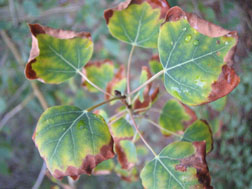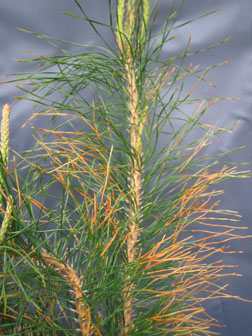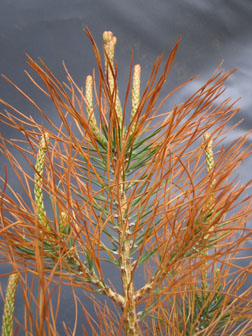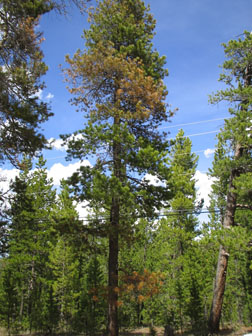by B.A. Goodrich and W.R. Jacobi* (12/14)
Quick Facts…
- Magnesium chloride (MgCl2) is a salt compound composed of Mg+2 and Cl– ions.
- Magnesium chloride (MgCl2) is used as a dust suppressant and road stabilizer on nonpaved roads and as a deicing product on paved roads and sidewalks.
- MgCl2 based products can move from treated roads into adjacent soils through precipitation.
- Trees take up soil magnesium and chloride through roots and accumulate them in leaves.
- To avoid chloride toxicity in roadside trees, use nonchloride based products to treat for dust suppression and deicing purposes.
MgCl2 Uses for Road Treatments
Along highways and city streets, liquid magnesium chloride (MgCl2) deicing solutions are applied during snow events, as preventative deicers, and as anti-icing treatments. Granulated MgCl2 is also commonly applied to sidewalks, driveways, and walkways in smaller quantities. Liquid MgCl2 solutions are applied to non-paved roads during spring and summer months for dust suppression and road stabilization, especially in arid regions.
MgCl2 Toxicity: Biology
Chloride (Cl–) and magnesium (Mg+2) are both essential nutrients important for normal plant growth. Too much of either nutrient may harm a plant, although foliar chloride concentrations are more strongly related with foliar damage than magnesium. High concentrations of MgCl2 ions in the soil may be toxic or change water relationships such that the plant cannot easily accumulate water and nutrients. Once inside the plant, chloride moves through the water-conducting system and accumulates at the margins of leaves or needles, where dieback occurs first. Leaves are weakened or killed, which can lead to the death of the tree.
Symptoms of Chloride Toxicity

Figure 1. Marginal burn on roadside aspen leaves. |
Chloride toxicity in woody plants initially develops as a marginal necrosis on deciduous leaves (Figure 1) or a tip burn or necrosis on conifer needles (Figure 2). Generally, the higher the foliar chloride concentrations, the more extensive the necrosis becomes. In prolonged exposures, necrosis moves toward the middle of the leaf in deciduous species and towards the base of the needle in conifers. Early leaf loss can also occur.
Necrosis is usually more severe on older conifer needles (i.e., those nearest the trunk). Sometimes newly flushed, or current season, needles are unaffected and remain green throughout the summer and fall. Deciduous species may not exhibit symptoms for several months after flushing new leaves. In some cases, foliar damage may appear on branches in a spiral pattern in the tree crown (Figure 3).
Some symptoms associated with exposure to deicing salt spray, aerosols, or road dust differ from root absorption. The side of the tree facing the road may exhibit more damage and needles may have surface deposits of salt crystals or dust. Trees exposed to MgCl2 aerosols are often, but not always, in soils with high MgCl2 concentrations and thus may show a range of symptoms.
 |
 |
|
Figure 2. Tip burn on conifer foliage. Low severity of tip burn (left). High severity of tip burn (right). |
||
Abiotic Disorders Similar to Chloride Toxicity
Drought effects, dehydration, winter burn, and some herbicide damage also appear as tip or marginal burning on trees. Water stress and dehydration may exacerbate chloride toxicity and cause even more extensive damage. There is no known method to fully separate the symptoms of chloride toxicity with water stress. Follow the diagnosis questions below and collect foliar samples to determine chloride content.
Diagnosis

Figure 3. Necrotic foliage “spiral” on roadside lodgepole pine crown. |
Eliminating other major biotic (insects, diseases) or abiotic (herbicide) damages to trees is the first diagnostic step, although these issues may also occur on trees already stressed by chloride toxicity. The next major factors useful in determining whether a tree is exposed to chloride are position and distance from the road, position in drainage or culvert areas, and eventually measuring chloride concentration in foliage.
Diagnostic Questions:
1. Does foliar damage occur only along the road or are many trees in the area affected?
Eliminate other potential causes by looking at the distribution of symptoms in the area. If many non-roadside trees in the area have similar symptoms this may be drought, winter burn, or needlecast fungi causing tip necrosis or a band of necrosis in the center of the needle. Check for insect frass and galleries on the stem, galls and cankers on stems and branches, or potential root disease and other biotic agents that might be causing stress to the tree. CSU Extension Bulletin 506A: Insects and Diseases of Woody Plants in Colorado lists common biotic damage agents, signs, and symptoms for many species of woody plants.
2. Are herbicides applied along the road or the walkway?
Some patterns of damage on herbicide-affected leaves include cupping and deformation of leaf shape in addition to marginal necrosis.
3. Is the road treated with MgCl2?
Additional Resources
|
If the road is or has been treated with MgCl2 products, it may have washed into surrounding soils. A splash and aerosol zone also occurs along treated paved roads and contributes to foliar accumulation of MgCl2. At very high soil concentrations, MgCl2 damage may appear on trees after two years of treatment.
4. Is the tree downhill from the road?
While trees uphill of MgCl2 may exhibit damage, the majority of foliar damage occurs on trees downhill from the road edge.
5. How far is the tree from the road edge?
On straight segments of non-paved roads most damage symptoms occur within 20 feet from the road. Along MgCl2 treated highways, a splash zone may extend 300 feet due to snowplowing, traffic, and the resulting aerial spray.
6. Is the tree in an area where a culvert discharges water from the road?
In areas where culverts discharge water from the road and areas adjacent to sharply banked roads, water and MgCl2 ions are concentrated and into drainage areas. High concentrations of MgCl2 ions in soil and plant tissue have been measured up to 300 feet from non-paved roads in drainage areas. No research is available on MgCl2 movement through culvert and drainage areas along highways treated for deicing purposes.
Recommendations for Sample Collection
- Chloride concentrations in leaves, rather than the soil, are a better indicator of potential damage to roadside trees.
- Collect foliar samples towards the end of summer or beginning of fall along non-paved roads. Collect samples in spring if trees are along roads treated for deicing purposes in the winter.
- Collect at least 30 grams (a handful or half a small paper lunch bag full) of two-year-old needles (from conifers) or current leaves (from deciduous trees) exhibiting tip burn from at least three different branches. Avoid collecting needles or leaves from shaded or the lowest branches. Avoid leaves that are not fully developed. Store samples in a cloth or paper bag (not plastic).
- Lightly rinse foliage with distilled water prior to analysis to eliminate dust or aerially deposited salts. If foliage has crystallized salt deposits, chloride concentrations will be extremely high and not indicative of foliar cellular content. If aerial spray or dust is suspected as causing needle symptoms, the water leachate (water used to rinse the foliage) can also be collected and tested for chloride content or electrical conductivity (EC: estimates the amount of total dissolved salts in a solution).
- If possible, ship samples the same day. If same day shipping is not possible store samples in a dry area or oven on low heat (less than 100 degrees F).
- Close and seal the shipping container to avoid contamination. Mail samples directly to the laboratory of your choice for analysis (see fact sheet 0.520, Selecting an Analytical Laboratory for a list of laboratory recommendations).
- Compare results of chemical analysis with the information in Table 1 to determine if the tree is exposed to chloride salts.
| Table 1. Foliar chloride concentrations (ppm) in seven common Colorado roadside tree species.1,2 | ||||
| Roadside Field Trees |
Shadehouse Trees
|
|||
| Species |
Background
|
Severe Foliar Damage3
|
Severe Foliar Damage4
|
Complete Foliar Damage5
|
| lodepole pine |
< 1,000
|
4,000
|
9,000
|
17,000
|
| aspen |
< 2,500
|
20,000
|
28,000
|
40,000
|
| Engelmann spruce |
< 1,000
|
6,500
|
—
|
—
|
| subalpine fir |
< 2,000
|
5,000
|
—
|
—
|
| ponderosa pine |
< 1,500
|
7,500
|
8,000
|
22,000
|
| Douglas-fir |
< 800
|
—
|
10,000
|
17,000
|
| limber pine |
< 700
|
—
|
—
|
—
|
| 1Concentrations in parts per million (ppm) (1 ppm = 1 mg/kg = 0.0001% dry weight) 2Concentration data from: Goodrich 2008 and ongoing shadehouse trials at CSU (non-published data). Dashes (-) indicate concentrations are not known. 3Concentrations necessary to cause ~50% crown damage in roadside field trees* 4Concentrations necessary to cause ~50% crown damage in shadehouse trial trees* 5Concentrations necessary to cause 100% crown damage in shadehouse trial trees* *Experimental shadehouse trees are well-watered and not exposed to drought stress like roadside field trees growing in ambient conditions. |
||||
Management
- No chemical treatments can reclaim saline soils (high in soluble salts), although proper drainage and flushing the soil with water can remove MgCl2 ions from the upper soil profiles (see fact sheet 0.503, Managing Saline Soils). Tree roots are extensive and may not benefit as much as agricultural crops from soil flushing.
- Use non-chloride based products on roads that run through forested areas, or on roads with sharp curves and steep slopes.
- Lowering application rates of MgCl2 may still cause damage to sensitive conifers. Even the lowest application rates may become concentrated in roadside ditches and move off the road via culvert systems and into drainage areas.
- Do not apply dust suppression products to non-paved roads immediately before or during rain.
- Select and use more tolerant trees if tolerance has been experimentally proven.
- Reduce exposure to deicing salts by minimizing the splash zone and aerial drift of deicing particulates (straw, fencing, other structures).
- The effectiveness of washing accumulated surface depositions from needles is not known, but it may help maintain healthy needles. Additional leaching to move salt through the soil is needed after needles are washed.
* B.A. Goodrich, department of bioagricultural sciences and pest management; and W.R. Jacobi, Colorado State University Extension specialist and professor, department of bioagricultural sciences and pest management. 7/08. Revised 12/14.
Colorado State University, U.S. Department of Agriculture, and Colorado counties cooperating. CSU Extension programs are available to all without discrimination. No endorsement of products mentioned is intended nor is criticism implied of products not mentioned.
Go to top of this page.





